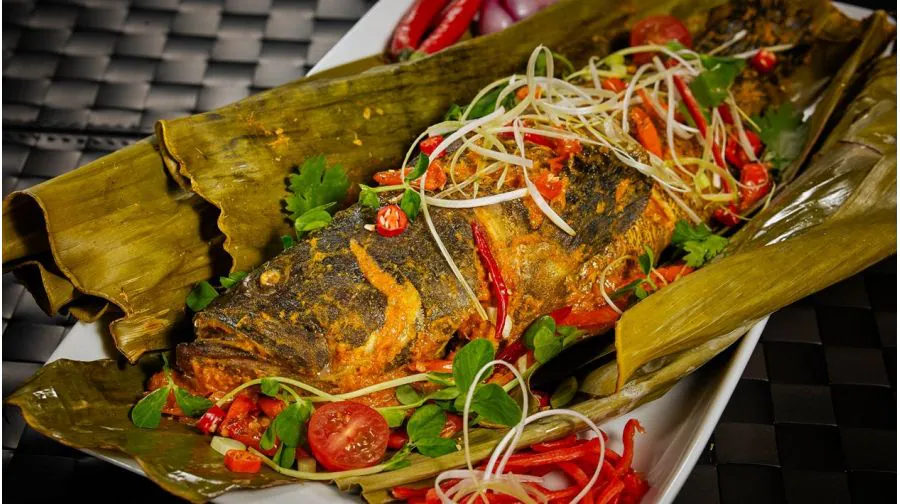Pepes is a popular Indonesian dish that primarily uses a unique cooking method of wrapping ingredients, usually fish or chicken, in banana leaves before steaming or grilling them. The banana leaves act as a natural wrapper, sealing in the juices and enhancing the flavors of the spices and herbs used. This method results in a highly aromatic, flavorful dish that is beloved in Indonesia and across Southeast Asia.
But Pepes is more than just a dish; it represents a rich culinary tradition. In Indonesia, food is more than sustenance—it’s a symbol of culture, history, and community. The process of preparing Pepes is a testament to this philosophy, where ingredients are carefully selected and cooking is done with attention to detail.
The History and Cultural Importance of Pepes
The origin of Pepes can be traced back to ancient Indonesia, where the use of banana leaves for cooking was widespread due to their availability and practical benefits. Wrapping food in banana leaves helps lock in moisture and adds a subtle aroma to the dish, which is why it became an integral part of Indonesian cuisine.
Historically, Pepes was a dish enjoyed by the aristocracy and commoners alike. Over time, it became a staple at traditional feasts, religious ceremonies, and family gatherings. Today, Pepes continues to hold a special place in Indonesian culture, with regional variations adding to its diversity. The dish has evolved with the times, but its core elements—banana leaves, fresh spices, and slow cooking—remain unchanged.
Ingredients Commonly Used in Pepes
One of the hallmarks of Pepes is its simplicity and versatility. While fish is the most common protein used, other ingredients like chicken, tofu, and vegetables are also popular. The magic of Pepes lies in its seasoning, which typically includes:
- Shallots and garlic: These aromatic ingredients form the base of many Indonesian dishes.
- Galangal and ginger: These root spices add warmth and depth to the flavor profile.
- Turmeric: Known for its bright color and earthy flavor, turmeric is essential in many Indonesian recipes, including Pepes.
- Candle nuts: These nuts add a creamy texture when ground into a paste.
- Lemongrass and kaffir lime leaves: These herbs infuse the dish with a fresh, citrusy fragrance.
The beauty of Pepes is that it’s highly adaptable. Different regions in Indonesia have their own versions, using local ingredients to create unique flavors. For instance, in West Java, they might add tamarind to give the dish a slightly sour kick, while in Bali, coconut milk is sometimes used for a creamier consistency.

The Pepes Cooking Method: Step-by-Step Guide
One of the reasons Pepes is so beloved is its simple yet flavorful cooking method. Here’s a step-by-step guide to preparing authentic Pepes at home:
Prepare the Ingredients
Start by gathering your protein (fish, chicken, or tofu) and marinating it with a paste made from shallots, garlic, galangal, turmeric, and candle nuts. You can also add chili peppers if you prefer a spicier dish.
Wrap in Banana Leaves
After marinating, wrap the protein and spices in banana leaves. The banana leaves should be large enough to completely cover the food. You can secure the leaves with toothpicks or string to ensure they stay wrapped during cooking.
Steam or Grill
Traditionally, Pepes is steamed for 30–40 minutes until the protein is cooked through. In some variations, the wrapped parcels are then grilled briefly to give the dish a smoky flavor.
Serve
Once cooked, the Pepes parcels are unwrapped and served directly from the banana leaves. The aroma of the spices and the tenderness of the protein make this a show-stopping dish.
Types of Pepes Dishes
Although Pepes originated as a fish dish, it has evolved over time to include various proteins and even vegetarian options. Here are some of the most popular types of Pepes you might encounter:
- Pepes Ikan: This is the classic version made with fish, usually mackerel or carp. It’s seasoned with turmeric, ginger, lemongrass, and chili.
- Pepes Ayam: Made with chicken, this version is heartier and often includes additional spices like coriander and cumin.
- Pepes Tahu: A vegetarian option made with tofu, this dish is lighter but just as flavorful.
- Pepes Jamur: For mushroom lovers, this variation features a medley of mushrooms wrapped in banana leaves with the signature Pepes spice mix.
Each type of Pepes offers a unique flavor experience, showcasing the versatility of this traditional cooking method.
Why Pepes is Gaining Popularity Worldwide
In recent years, Pepes has started gaining attention outside of Indonesia, and for good reason. The rise of global interest in Southeast Asian cuisine has brought dishes like Pepes into the spotlight. Foodies around the world are embracing this dish for its:
- Unique Cooking Method: The use of banana leaves as a natural wrapper gives Pepes an edge in terms of flavor and presentation. It’s a sustainable, eco-friendly alternative to foil or plastic, appealing to the environmentally conscious.
- Health Benefits: The steaming and grilling process makes Pepes a healthier option compared to deep-fried dishes. Plus, the use of fresh herbs and spices means that Pepes is packed with nutrients.
- Customizability: As a dish that can be made with various proteins, Pepes caters to a wide range of dietary preferences, including vegetarian and pescatarian options.
Health Benefits of Pepes
Given its method of preparation and ingredients, Pepes offers a variety of health benefits. Steaming preserves the nutrients in the food, while the spices used in Pepes have anti-inflammatory and antioxidant properties. Turmeric, for example, is known for its ability to reduce inflammation, while garlic and ginger are both excellent for boosting the immune system.
Moreover, the banana leaves used in Pepes add a subtle aroma without adding extra calories or unhealthy fats, making it an excellent choice for those looking to eat healthily without sacrificing flavor.
Pepes in Modern Cuisine
While Pepes is firmly rooted in traditional Indonesian cuisine, it has found its way into modern kitchens around the world. In contemporary restaurants, chefs are experimenting with Pepes by using different proteins like shrimp or even lamb. Some chefs are also giving it a global twist by incorporating non-Indonesian spices or using alternative leaves for wrapping, such as corn husks.
Additionally, with the rise of veganism and plant-based diets, many are turning to Pepes as a flavorful, plant-based dish that doesn’t rely on processed ingredients.
How to Make Pepes at Home
If you’re looking to bring the taste of Indonesia into your kitchen, making Pepes at home is easier than you might think. Here’s a simple recipe to get you started:
Ingredients:
- 4 fillets of fish (or your preferred protein)
- 2 cloves of garlic
- 5 shallots
- 1 thumb-sized piece of ginger
- 1 stalk of lemongrass
- 1 tsp turmeric
- 1 tbsp oil
- 4 large banana leaves
Instructions:
- Blend garlic, shallots, ginger, and turmeric into a paste.
- Rub the paste onto the fish fillets and let them marinate for at least 30 minutes.
- Wrap each fillet in a banana leaf and secure with toothpicks.
- Steam the wrapped fish for 30 minutes or until fully cooked.
- Optionally, grill the parcels for an additional 5 minutes to add a smoky flavor.
- Serve and enjoy!
Conclusion
Pepes is not just a dish; it’s a celebration of flavor, tradition, and culture. Its growing popularity around the world is a testament to the versatility and deliciousness of this traditional Indonesian cooking method. Whether you’re trying it at a restaurant or making it at home, Pepes offers an unforgettable culinary experience that showcases the best of Southeast Asian cuisine.
So why not give it a try? Whether you’re a seasoned chef or a home cook, Pepes is a dish that anyone can enjoy—and once you’ve had a taste, you’ll understand why it’s cherished by so many.
FAQs
1. What is Pepes?
Pepes is an Indonesian cooking method where ingredients, usually fish or chicken, are wrapped in banana leaves and steamed or grilled.
2. Can I make Pepes without banana leaves?
While banana leaves add a unique flavor, you can use aluminum foil, but the result won’t be quite the same.
3. Is Pepes healthy?
Yes, Pepes is a healthy dish due to its use of fresh ingredients and the steaming or grilling method, which preserves nutrients.
4. What spices are used in Pepes?
Common spices in Pepes include garlic, shallots, ginger, turmeric, and lemongrass.
5. Can I use other proteins in Pepes?
Yes! Pepes can be made with chicken, tofu, vegetables, and even shrimp or mushrooms






